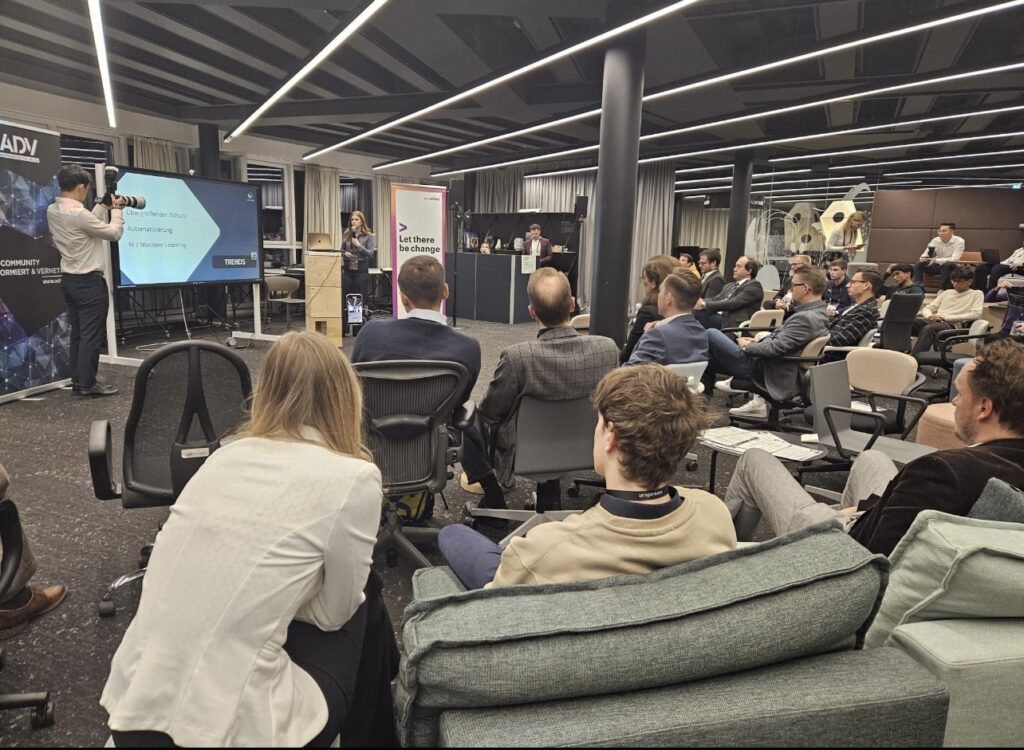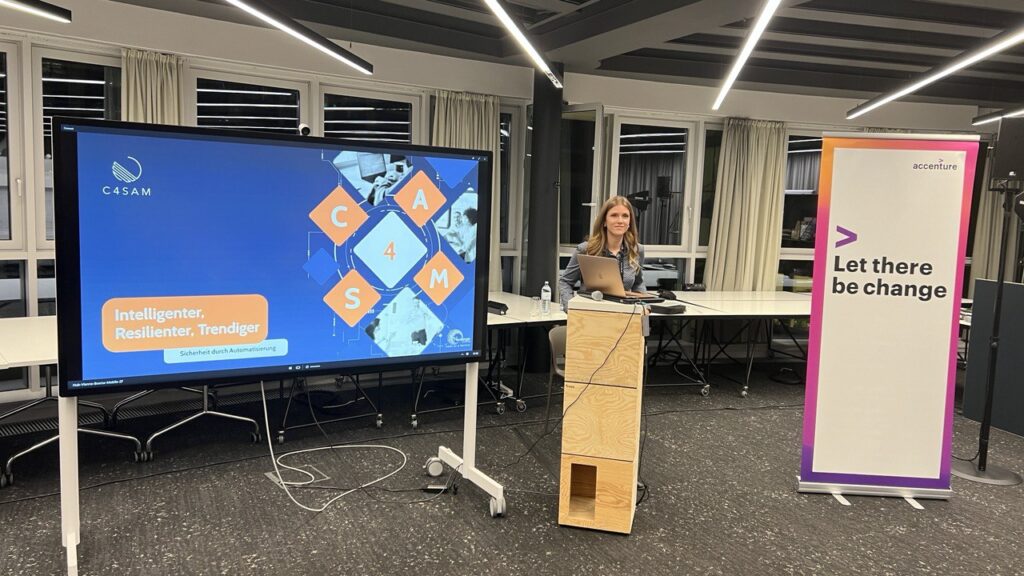Bridging the gap Combining Cloud and On-Premise Security with C4SAM...
Read MoreCybersecurity trends 2024
Intelligent & Resilient - Security through Automation

In the fast-evolving landscape of cybersecurity, staying ahead of emerging threats is paramount. As we usher in 2024, it’s crucial to examine the trends that will shape the future of digital defense. Let’s delve into the key cybersecurity trends of 2024 and explore how organizations can fortify their defenses.
Watch our video or read the text below.

By loading the video, you agree to YouTube's privacy policy.
Learn more
ADV Trends- Gamechanger IT: Innovate 4 Resilience
On November 30th, 2023 we had the honor to talk about the Cybersecurity Trends 2024. Here are some impressions.



Trend #1: Comprehensive protection
The foremost trend centers around comprehensive protection, ensuring a unified shield across the entire IT infrastructure. Many companies currently employ isolated solutions for specific segments, leading to challenges in communication and a lack of visibility across the entire infrastructure. Understanding that a system is only as secure as its weakest link, the focus is on developing strategies for all-encompassing protection.
Trend #2: Automation
The Key to Efficiency and Rapid Response: Automation takes center stage as a pivotal trend in 2024. Efficiency gains and swift responses to cyber threats are the driving forces. Recognizing that merely identifying threats isn’t enough, organizations are embracing automation to respond promptly. Machine learning and artificial intelligence (AI) play critical roles in early detection of attack patterns, highlighting the significance of this trend in the evolving cybersecurity landscape.
Trend #3: AI / Machine Learning
In this case, Machine Learning means that algorithms are defined to detect attack patterns in advance. Artificial Intelligence (AI) would be the next step, where these algorithms are automatically generated.
And although AI is an extension of automation, it must be viewed as a complement. There are some cases where it still doesn’t make sense for rules to be automatically created. For instance, in compliance, especially in the definition of controls.
Security should be envisioned as a journey. It’s not a piece of software that you install once, and you’re secure. Instead, you go through phases, and the further you progress, the higher the maturity level of IT security in the company.
Phase 1: Security
So, the standard approach is to start with a discovery, understanding what network devices and services are present in my IT infrastructure and how they communicate or what their respective responsibilities are. This forms the foundational knowledge. Simply put, you need to know what you have to manage it effectively.
Next, we assess together which services are actually business-critical. What impact would it have on your company if a particular service were to fail? These business-critical services are then immediately sent to monitoring. The “M” in C4SAM stands for monitoring, a crucial accompanying tool.
Moving on, we conduct a vulnerability analysis in the next step to determine “Where am I vulnerable?” These vulnerabilities are then evaluated based on three factors: the severity of the vulnerability, the existence of known incidents, and the potential impact.
In the subsequent step, we address and fix these vulnerabilities. This involves integrating all data sources, such as log files, and incorporating all security-relevant information. The resolution process can be categorized into three types:
1. If there’s a vendor fix (patch/update) available, deploy it immediately.
2. If a configuration change is necessary, initiate the change.
3. If there’s no solution, either shut down the service or establish other protective measures, such as network segmentation.
Phase 2: Automation
So, now we’ve reached the automation phase.
This is where Machine Learning comes into play. As we heard before, Machine Learning and AI help in detecting attack patterns and abnormal behavior early on.
The next step is attack detection.
In response to these attacks, one must react as quickly as possible, ideally in an automated manner. In the simplest case, this could be a notification to a responsible person or team. Alternatively, it could involve blocking an IP address, and, crucially, automatically generating log files for forensic analysis.
At the end of the day, the focus is on resilience. In the event of an outage, rapid restoration is essential. The challenge lies not in the restoration itself, but in the duration of the restoration. Automation is crucial here too, minimizing downtime.
Another critical aspect is the automation of processes within the company. One of the most common reasons for attacks is “Unmanaged Changes,” which refers to manual alterations.
Consider a classic scenario: a service is installed, secure, and compliant. Then, an employee independently makes an adaptation, undoubtedly with good intentions and conscientiousness. However, this doesn’t guarantee error-free modifications, potentially rendering the service vulnerable. The employee leaves for the weekend, the vulnerability is exploited, and on Monday, everyone returns to the office to find it not functioning. I won’t delve into the worst-case scenario where the employee may be on vacation and unreachable. Even if the employee works diligently, there’s a chance they forgot to document the change. This means that no one can trace the cause, highlighting the significant difference with automation. Everything automated is not only more efficient and error-free but also documented, making it reversible or repeatable.
This brings me to the next topic: automation in compliance – specifically, NIS 2. Compliance essentially comprises two components: defining controls and conducting assessments, going through and checking off what is in place. Currently, this is often done manually in a list.
We take all the data we collect during discovery and vulnerability analysis and prepare it so that it can be automated for compliance. This, in turn, enables the generation of reports for certifications or audits.
Phase 3: Cockpit
So, what does it take for a company to be protected in today’s world?
We’ve heard that it requires comprehensive protection across the entire infrastructure, enriched with AI and automation for efficiency and responsiveness. And if you’ve integrated all of this into a solution, one that is applicable to businesses of all sizes because we know that even, or especially, small and medium-sized enterprises are vulnerable. Furthermore, a tool for compliance is also integrated, providing protection not only against attacks but also against regulations.
All of this integrated and neatly presented in a single interface, our cockpit –
That is C4SAM – Cockpit for security, automation & monitoring.
Other blog posts
Critical Boot Loader Vulnerability in Shim
Critical vulnerability in the Shim boot loader What to do?...
Read MoreCybersecurity Trends 2024
Cybersecurity trends 2024 Intelligent & Resilient – Security through Automation...
Read MoreCybersecurity Kill Chain
What is a Cybersecurity Kill Chain? understanding, detecting, and preventing...
Read MoreWhy should SMEs be interested in cybersecurity awareness
Why should anyone target us? Why should SMEs be interested...
Read MoreTop 8 Prediction for Cybersecurity within the next 2 years
Top 8 Prediction for Cybersecurity within the next 2 years...
Read More